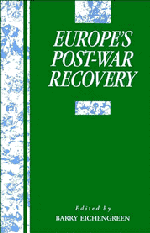Book contents
- Frontmatter
- Contents
- List of contributors
- Preface
- Part I Introduction and survey
- Part II The Marshall Plan
- Part III Other international initiatives
- Part IV Country studies
- 8 Germany and the political economy of the Marshall Plan, 1947–52: a re-revisionist view
- 9 “You've never had it so good?”: British economic policy and performance, 1945–60
- 10 “Belgian miracle” to slow growth: the impact of the Marshall Plan and the European Payments Union
- 11 France: real and monetary aspects of French exchange rate policy under the Fourth Republic
- Part V Synthesis
- Index
11 - France: real and monetary aspects of French exchange rate policy under the Fourth Republic
Published online by Cambridge University Press: 07 September 2010
- Frontmatter
- Contents
- List of contributors
- Preface
- Part I Introduction and survey
- Part II The Marshall Plan
- Part III Other international initiatives
- Part IV Country studies
- 8 Germany and the political economy of the Marshall Plan, 1947–52: a re-revisionist view
- 9 “You've never had it so good?”: British economic policy and performance, 1945–60
- 10 “Belgian miracle” to slow growth: the impact of the Marshall Plan and the European Payments Union
- 11 France: real and monetary aspects of French exchange rate policy under the Fourth Republic
- Part V Synthesis
- Index
Summary
Introduction
French international economic policy after World War II was torn between principle and practice. The principles were provided by a set of newly established international institutions which sought to constrain the conduct of trade and exchange rate policy. The Articles of Agreement of the International Monetary Fund committed France to the maintenance of fixed exchange rates. As a signatory of the GATT and a member of the OEEC, post-war France was committed to the restoration of free trade.
Practice was based on urgency and, with hindsight, diverged markedly from principle. Given the burdens of reconstruction and two colonial wars, the French economy had to cope with exceptional challenges: chronic inflation and budget deficits, shortages of consumer goods, social strife, wage pressure, and the threat of capital flight. These problems led to a succession of balance of payments crises in 1948, 1951, and 1957.
As a result, France was faced with the choice of compromising its commitment to either free trade or exchange rate stability. It opted for devaluation between 1945 and 1949 and for trade controls in the subsequent period.
This experience suggests a number of questions which may be relevant to other contexts including that of the transition economies of Eastern Europe and the former Soviet Union today. What is the best international monetary arrangement for a period of reconstruction and reform? What is the optimal level for the real exchange rate?
- Type
- Chapter
- Information
- Europe's Postwar Recovery , pp. 292 - 320Publisher: Cambridge University PressPrint publication year: 1995
- 1
- Cited by



